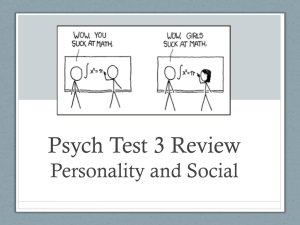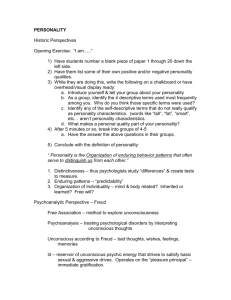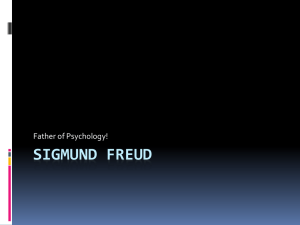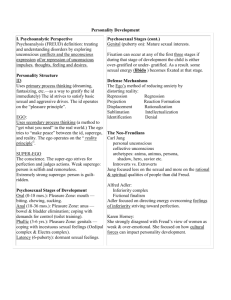Answer Key - Deerfield High School
advertisement
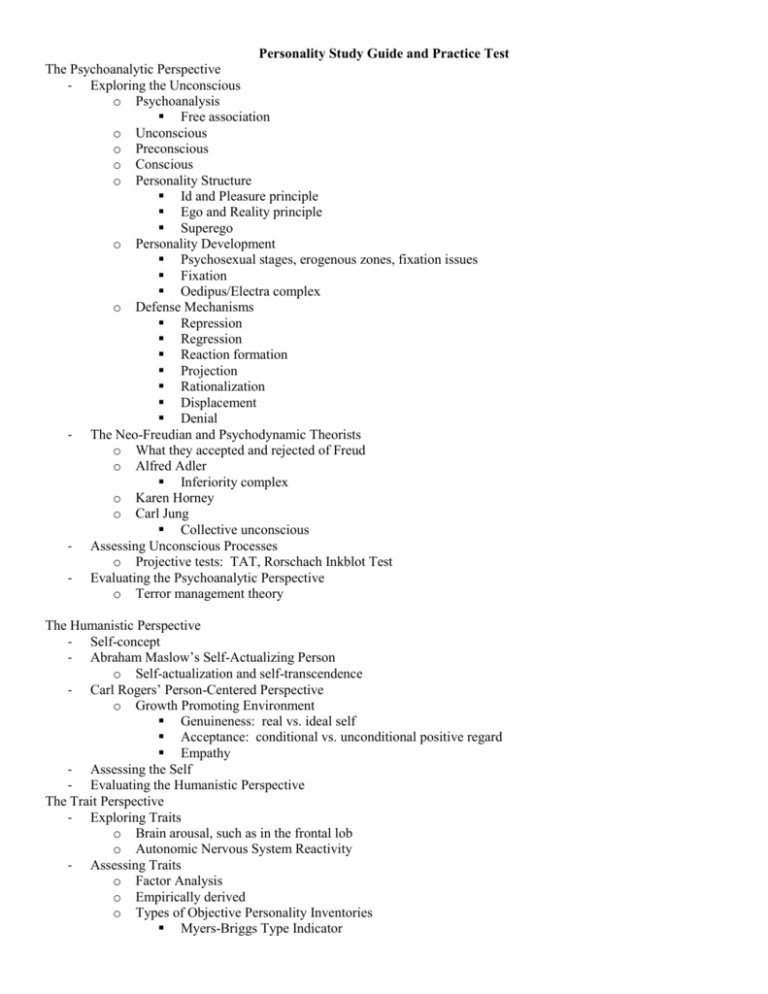
Personality Study Guide and Practice Test The Psychoanalytic Perspective - Exploring the Unconscious o Psychoanalysis Free association o Unconscious o Preconscious o Conscious o Personality Structure Id and Pleasure principle Ego and Reality principle Superego o Personality Development Psychosexual stages, erogenous zones, fixation issues Fixation Oedipus/Electra complex o Defense Mechanisms Repression Regression Reaction formation Projection Rationalization Displacement Denial - The Neo-Freudian and Psychodynamic Theorists o What they accepted and rejected of Freud o Alfred Adler Inferiority complex o Karen Horney o Carl Jung Collective unconscious - Assessing Unconscious Processes o Projective tests: TAT, Rorschach Inkblot Test - Evaluating the Psychoanalytic Perspective o Terror management theory The Humanistic Perspective - Self-concept - Abraham Maslow’s Self-Actualizing Person o Self-actualization and self-transcendence - Carl Rogers’ Person-Centered Perspective o Growth Promoting Environment Genuineness: real vs. ideal self Acceptance: conditional vs. unconditional positive regard Empathy - Assessing the Self - Evaluating the Humanistic Perspective The Trait Perspective - Exploring Traits o Brain arousal, such as in the frontal lob o Autonomic Nervous System Reactivity - Assessing Traits o Factor Analysis o Empirically derived o Types of Objective Personality Inventories Myers-Briggs Type Indicator Eysenck Personality Questionnaire MMPI - The Big Five Factors - Thinking Critically About: How to Be a Successful Astrologer or Palm Reader o Barnum effect - Evaluating the Trait Perspective o Person-situation controversy The Social-Cognitive Perspective - Reciprocal Influences - Personal Control o Internal vs external locus of control Learned helplessness Tyranny of choice - Optimistic vs. Pessimistic Attributional Style - Close-Up: Toward a More Positive Psychology - Assessing Behavior in Situations - Evaluating the Social-Cognitive Perspective Exploring the Self - Possible selves: self you dream of becoming and self you fear becoming - Spotlight effect - The Benefits of Self-Esteem - Self-Serving Bias Practice Test ___ 1. Trait theorists are more concerned with ________ personality than ________ it. A) predicting; assessing B) describing; explaining C) changing; analyzing D) interpreting; observing ___ 2. Abdul mistakenly believes that his classmates at school are unusually hostile. In fact, Abdul is the most quarrelsome and aggressive child in the school. According to psychoanalytic theory, Abdul's belief that his classmates are hostile is a: A) regression. B) projection. C) fixation. D) reaction formation. ___ 3. The Oedipus and Electra complexes have their roots in the: A) anal stage. B) oral stage. C) latency stage. D) phallic stage. E) genital stage. ___ 4. Mr. Hendriks, a high school teacher, washes the chalkboard and realigns student desks in precise rows before every class. According to the psychoanalytic perspective, Mr. Hendriks is most likely fixated at the ________ stage. A) phallic B) oral C) latency D) genital E) anal ___ 5. A person who is careless and disorganized most clearly ranks low on the Big Five trait dimension known as: A) emotional stability. B) extraversion. C) openness. D) agreeableness. E) conscientiousness. ___ 6. After experiencing inescapable brutalities as a prisoner in a Nazi concentration camp, Mr. Sternberg became apathetic, stopped eating, and gave up all efforts to physically survive the ordeal. Mr. Sternberg's reaction most clearly illustrates: A) an inferiority complex. B) repression. C) learned helplessness. D) an internal locus of control. E) reaction formation. ___ 7. The Minnesota Multiphasic Personality Inventory (MMPI) is what type of personality test? A) projective B) empirically derived and objective C) developed mainly to assess job applicants D) used primarily to assess locus of control ___ 8. Freud became interested in unconscious personality dynamics when he noticed that certain patients' symptoms: A) resulted from the physical abuse they received from their parents during childhood. B) resulted from the loss of an internal locus of control. C) could not be removed by means of hypnosis. D) could not be explained readily in terms of neurological impairments. ___ 9. Which theorist emphasized that personal growth is promoted by interactions with others who are genuine, accepting, and empathic? A) Allport B) Jung C) Rogers D) Freud E) Bandura ___ 10. The social-cognitive perspective suggests that the best way to predict a political candidate's performance effectiveness after election is to assess that individual's: A) current feelings of personal control. B) specific political goals for the future. C) general feelings of optimism about the future. D) past performance in situations involving similar responsibilities. E) personality traits as revealed by the MMPI-2. ___ 11. The text defines personality as A) the set of personal attitudes that characterizes a person. B) an individual's characteristic pattern of thinking, feeling, and acting. C) a predictable set of responses to environmental stimuli. D) an unpredictable set of responses to environmental stimuli. ___ 12. Sheen is usually animated and talkative when he is with his girlfriend, but he is often quiet and reserved at home. He actively participates in many classroom discussions but frequently seems reluctant to talk with friends at the campus coffee shop. According to Walter Mischel, Sheen's behavior should lead us to question the importance of: A) personality traits. B) unconditional positive regard. C) reciprocal determinism. D) defense mechanisms. E) self-efficacy. ___ 13. Laura fails to recognize any connection between her unsafe sexual practices and the likelihood of contracting a sexually transmitted disease. Laura's lack of perceptiveness best illustrates the dangers of: A) free association. B) an Electra complex. C) the Barnum effect. D) an external locus of control. E) unconditional positive regard. ___ 14. Sharon was an abused child; as an adult, she is homeless and squanders any money she can find on alcohol. Alfred Adler would have suggested that Sharon suffers from: A) an Electra complex. B) role confusion. C) an oral fixation. D) feelings of inferiority. E) the Barnum effect. ___ 15. (Close-Up) During a class discussion, Trevor argues that positive psychology is sure to wane in popularity because it suffers from the same criticisms as humanistic psychology. You counter his argument by pointing out that, unlike humanistic psychology, positive psychology A) focuses on advancing human fulfillment. B) is rooted in science. C) is not based on the study of individual characteristics. D) has all of these characteristics. ___ 16. Which of the following is most likely to contribute to raising one's self-esteem? A) free association B) an Electra complex C) self-serving bias D) an external locus of control E) the Barnum effect ___ 17. A psychoanalyst would characterize a person who is impulsive and self-indulgent as possessing a strong ________ and a weak ________. A) id and ego; superego B) id; ego and superego C) ego; superego D) id; superego ___ 18. Nadine has a relatively low level of brain arousal. Trait theorists would probably predict that she is: A) an extravert. B) an introvert. C) an unstable person. D) both a. and c. ___ 19. According to Freud's theory, personality arises in response to conflicts between A) our unacceptable urges and our tendency to become self-actualized. B) the process of identification and the ego's defense mechanisms. C) the collective unconscious and our individual desires. D) our biological impulses and the social restraints against them. ___ 20. Mr. Dutoit was asked by his psychotherapist to look at some ambiguous pictures and make up a story about each. Mr. Dutoit was most likely taking the: A) TAT. B) Myers-Briggs Type Indicator. C) MMPI-2. D) Personal Orientation Inventory. E) Rorschach test. ___ 21. Which of the following is the correct order of psychosexual stages proposed by Freud? A) oral; anal; phallic; latency; genital B) anal; oral; phallic; latency; genital C) oral; anal; genital; latency; phallic D) anal; oral; genital; latency; phallic ___ 22. Research has shown that individuals who are made to feel insecure are subsequently: A) more critical of others. B) less critical of others. C) more likely to display a self-serving bias. D) less likely to display a self-serving bias. ___ 23. The humanistic perspective on personality A) emphasizes the driving force of unconscious motivations in personality. B) emphasizes the growth potential of “healthy” individuals. C) emphasizes the importance of interaction with the environment in shaping personality. D) describes personality in terms of scores on various personality scales. ___ 24. Collectivist cultures: A) give priority to the goals of their groups. B) value the maintenance of social harmony. C) foster social interdependence. D) are characterized by none of the above. E) are characterized by a., b., and c. ___ 25. Which of the following techniques did Freud use to discover the latent content of his patients' dreams? A) fixation B) factor analysis C) projective testing D) free association E) the Barnum effect Answer Key 1. 2. 3. 4. 5. 6. 7. 8. 9. 10. 11. 12. 13. 14. 15. 16. 17. 18. 19. 20. 21. 22. 23. 24. 25. B B D E E C B D C D B A D D B C D A D A A A B E D
